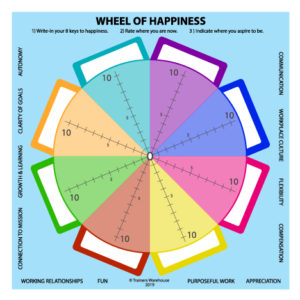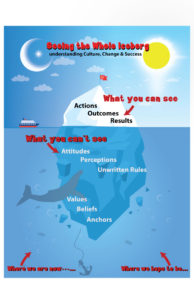Leadership Activities & Games
So much has been written on leadership and the qualities of a good leader. While you may find some differences across articles, the basic message is the same — share your sense of purpose; be transparent about your vision and goals; show empathy; empower your team; be flexible; communicate relentlessly; be adaptable; be decisive; and so on.
The suggestions are all well-grounded and researched. However, they don’t say much about how to develop those skills. They don’t offer a menu of leadership experiences and exercises — leadership activities — that draw out learning moments. If you’re looking to implement those tips and translate them into actionable skills, the exercises and tools below will help managers become the more effective leaders they hope to be.
Leadership Activities for Today’s Challenges
As Jamie Thompson of MTa Learning says, senior execs often want to jump into a very complex leadership activity before they’ve become skilled at building teams. “Think about how you sequence your games and create a journey for learning.”
As such, before selecting a game, activity, or experience, do a quick assessment to know where you are now and where you hope to grow. You may explore basic leadership skills through a Leadership Skills Assessment like HRDQs. With that insight, you can layer your more specific goals, such as…
- Build stronger teams
- Develop emotional intelligence
- Motivate smaller groups of staff who are taking on new challenges and wearing more hats
- Develop coaching and mentoring skills, to complement virtual training
- Blend divergent company cultures brought together by mergers and acquisitions
- Bring a sense of calm and mindfulness to workers who are stressed
- Build relationships torn apart by political divides
- Virtual communication, leadership, and team development experiences

Get conversations going with meaningful conversation prompts
While leaders face increasingly complex situations, the task of developing strong leaders is also tougher because of the imposition of remote and hybrid work environments. Trainers, like leaders, must quickly shift from in-person only experiences to blended and virtual learning.
Moreover, managers and leaders might require more intellectually and cognitevely demanding activities that reflect the complexity of their work environment. Consider these needs as you weight the leadership games, activities, tools and resources described below.
1. Build stronger teams — allocate time to building communincaiton and relationships!
Conversation Starters
Relationship building takes time. Whether teams are remote or in-person, allocate some “water cooler time,” that is time to simply chat. Having a few good prompts on hand helps. Thumballs, UNZiP-IT! Decks and UNZiP-IT! Remote PPTs all have the same great prompts to get your group talking. The wide variety of topics lets you choose appropriate prompts, whether your group is just getting acquainted (Common Ground, Shaped by Our Past, or Favorites), knows each other well but wants to build stronger bonds (Getting to Know You or What Makes You YOU?), or hopes to dig into deeper topics like Get Happy at Work, Diversity, Stress Management, Team Dynamics, etc.
Skill Development
Soft-skills training (leadership, communication, listening, time management, empathy, trust) has traditionally taken the form of face-to-face or blended learning. Beyond explanations and presentations, skill development typically requires conversation, role-playing, trial and error, and simulations that give participants a shared–and safe–experience to discuss, analyze, and extract learning. The following tools can be used in person or online.
- Leadership Metaphor Explorer Kit – This deck of 83 postcard-size cards is illustrated with a rich variety of drawings and captions is designed to help people understand how leadership plays out in their organizations, communities, and across boundaries.
- Minefield Maze Game – When a group needs to get a blindfolded team member through a maze, explore how leaders emerge, how to organize multiple voices, develop trust and more.
2. Develop Emotional Intelligence
- Help leaders develop a vocabulary for emotional intelligence (motivation, self-awareness, self-regulation, empathy, social skills), as well as for emotions and feelings. Resources such as EQ games, card decks, EQ Thumballs, or a Mood Matrix will come in handy.

3. Motivate smaller groups of staff who are taking on new challenges and wearing more hats
- Say Thanks with Kudos Notes & Cards – Positive feedback is key for growth and learning. While team members may typically look to leaders, managers or supervisors for words of appreciation, the happiest organizations also see peers reaching out to one another to express thanks or recognize a contribution. Give your staff the tools they need to acknowledge each others contributions, such as Mini Kudos Notes, Kudos for Colleagues, or Tokens of Appreciation. These can be put as someone’s desk, mailed or even emailed.
- Talk it out with Thumballs and UNZiP-IT! – Give your group a vehicle to express themselves. Pick a topic like Get Happy at Work or Team Dynamics and find out how you can better support your team.
- Wheel of Happiness – Use this popular self-assessment tool to assess your group’s happiness or satisfaction at work. See what each person needs to find themselves in a happier place.
- Challenge small groups to build a Marshmallow Tower as tall as can be. Welcome creativity, trial and error, and team spirit.
4. Develop coaching and mentoring skills, to complement virtual training
To develop and train smaller groups of people, organizations will need many more trainers. Or, they will also need to teach managers and colleagues to train and coach one another.
- Get Fit for Coaching – Help non-trainers (or even experienced coaches) get in shape and hone the skills they need to help their colleagues grow.
- View Changer Cards – Encourage coaches to utilize photographic imagery and metaphors to help their learners make connections, and express frustrations or goals.
5. Blend divergent company cultures brought together by mergers and acquisitions
Use one of these powerful metaphors to facilitate rich conversations about current and preferred situations.
- Road to There – discuss where you are, where you’re going, and the roadblocks to getting “There.”
- Vision Tree – use the metaphor of a tree to discover the roots that ground you, the systems that support you (trunk), and the fruit you hope to bear.
 Iceberg – talk about the unspoken ideas and assumptions that lie below the surface, but still affect work processes, environment, and relationships. Differentiate the visible (Actions, Outcomes, and Results) from the invisible (Attitudes, Perceptions, Unwritten Rules, Unconscious Biases, Values, Beliefs and Anchors).
Iceberg – talk about the unspoken ideas and assumptions that lie below the surface, but still affect work processes, environment, and relationships. Differentiate the visible (Actions, Outcomes, and Results) from the invisible (Attitudes, Perceptions, Unwritten Rules, Unconscious Biases, Values, Beliefs and Anchors).
6. Bring sense of calm and mindfulness to workers who are stressed and seeing co-workers laid-off
- Stress Thumball – Discuss triggers that create stress, as well as the tools and techniques to ground and calm your team.
- Mindfulness Deck – Mindfulness practices help build skills of awareness, compassion and presence for what matters in your daily life.
7. Build relationships torn apart by political divides
- Building Bridges Thumball / UNZiP-IT! – Focus on values you share rather than those that divide you. Develop trust by getting to know one another’s values.
- Develop Politics-Free Zones – use the DeskMate Politics-Free Zone sign to identify safe spaces to discuss anything but politics.
- Diversity Thumball / UNZiP-IT! – Use the prompts on these tools to understand sources of bias and experiences of feeling different.
8. Virtual Communication Games
Human beings rely on proximity and facial expressions to communicate non-verbally and show empathy. When we’re physically separated, the challenge can be more difficult. Still, many who create experiential games, developed online version during the pandemic. These continue to grow and proliferate as remote work remains the norm for many organizations.
Seeing the Point Online
In this game, players must assemble an assortment of shapes to make 4 uniform shapes.
Murder Mystery – Online Matrix Challenge
Use this popular 30-minute Murder Mystery game to improve communication skills, team building, problem-solving, leadership, and more. Send one or more of the 27 clues to each participant and challenge them to find the murderer, victim, time & place of the murder, and motive in 15 minutes — without writing anything down and using only verbal communication. If you have a large group, do make use online breakout rooms. After each team plays, they can select a spokesperson to share their team’s experience with the rest of the group.
Zin Obelisk – Online Matrix Challenge
A challenging mathematical puzzle Is made even more complex, by using made-up words in the fictitious, ancient city of Atlantis, where a solid, rectangular obelisk -called a zin – was built in honor of the goddess Tina. The structure took less than two weeks to complete and the group’s task is to determine the day of the week on which the obelisk was completed. For virtual play, email a few clues to each player and try to sort it out over the phone–maybe with a shared online whiteboard! After all clear phone communication is more important now than ever! Normally, teams consist of 5-8 players. If you have a larger group of people you can use online breakout rooms. After each team plays, they can select a spokesperson to share their team’s experience with the rest of the group.
Colourblind – Online
Virtual Teams of ideally 6 – 14 members gather and share knowledge to identify 2 colored abstract shapes that are missing from a complete set. If you have a larger group of people you can use online breakout rooms. After each team plays, they can select a spokesperson to share their team’s experience with the rest of the group. The communication processes involved are much more complex and take participants through increasingly sophisticated patterns of active listening until the task is achieved. Individuals draw on their experience and descriptive skills to explain to each other abstract shapes that they can see on their screens, but cannot share with the others. They use feedback and clarification skills to ensure that their understanding is accurate.
Climer Cards
Create an online experience of using illustrated images to develop metaphors to explain complex thoughts, ideas, or feelings.
Lead by Example with Leadership Activities
Leadership Games come in many formats. Whenever you take time out of your leaders’ busy days, be sure you have a clear purpose. On top of that, make the time worthwhile, but carving out a few additional minutes to debrief. Of course, if we’ve missed any of YOUR favorite Leadership Games, let us know!
Read More
Emotional Intelligence Exercises

